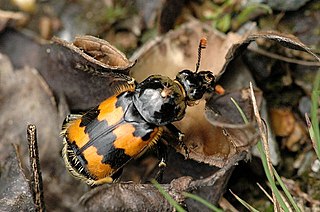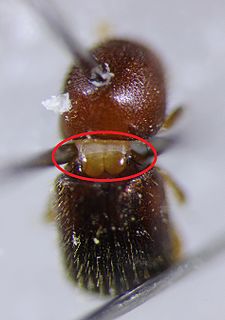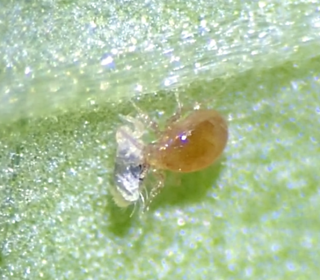
Forensic entomology is the scientific study of the invasion of the succession pattern of arthropods with their developmental stages of different species found on the decomposed cadavers during legal investigations. It is the application and study of insect and other arthropod biology to criminal matters. It also involves the application of the study of arthropods, including insects, arachnids, centipedes, millipedes, and crustaceans to criminal or legal cases. It is primarily associated with death investigations; however, it may also be used to detect drugs and poisons, determine the location of an incident, and find the presence and time of the infliction of wounds. Forensic entomology can be divided into three subfields: urban, stored-product and medico-legal/medico-criminal entomology.

Silphidae is a family of beetles that are known commonly as large carrion beetles, carrion beetles or burying beetles. There are two subfamilies: Silphinae and Nicrophorinae. Nicrophorines are sometimes known as sexton beetles. The number of species is relatively small and around two hundred. They are more diverse in the temperate region although a few tropical endemics are known. Both subfamilies feed on decaying organic matter such as dead animals. The subfamilies differ in which uses parental care and which types of carcasses they prefer. Silphidae are considered to be of importance to forensic entomologists because when they are found on a decaying body they are used to help estimate a post-mortem interval.

Hydrophilidae, also known colloquially as water scavenger beetles, is a family of chiefly aquatic beetles. Aquatic hydrophilids are notable for their long maxillary palps, which are longer than their antennae. Several of the former subfamilies of Hydrophilidae have recently been removed and elevated to family rank; Epimetopidae, Georissidae, Helophoridae, Hydrochidae, and Spercheidae. Some of these formerly-included groups are primarily terrestrial or semi-aquatic.

Histeridae is a family of beetles commonly known as clown beetles or Hister beetles. This very diverse group of beetles contains 3,900 species found worldwide. They can be easily identified by their shortened elytra that leaves two of the seven tergites exposed, and their geniculate (elbowed) antennae with clubbed ends. These predatory feeders are most active at night and will fake death if they feel threatened. This family of beetles will occupy almost any kind of niche throughout the world. Hister beetles have proved useful during forensic investigations to help in time of death estimation. Also, certain species are used in the control of livestock pests that infest dung and to control houseflies. Because they are predacious and will even eat other Hister beetles, they must be isolated when collected.

The emerald ash borer, also known by the acronym EAB, is a green buprestid or jewel beetle native to north-eastern Asia that feeds on ash species. Females lay eggs in bark crevices on ash trees, and larvae feed underneath the bark of ash trees to emerge as adults in one to two years. In its native range, it is typically found at low densities and does not cause significant damage to trees native to the area. Outside its native range, it is an invasive species and is highly destructive to ash trees native to Europe and North America. Before it was found in North America, very little was known about emerald ash borer in its native range; this has resulted in much of the research on its biology being focused in North America. Local governments in North America are attempting to control it by monitoring its spread, diversifying tree species, insecticides, and biological control.

A bark beetle is one of about 6,000 species in 247 genera of beetles in the subfamily Scolytinae. Previously, this was considered a distinct family (Scolytidae), but is now understood to be a specialized clade of the "true weevil" family (Curculionidae). Although the term "bark beetle" refers to the fact that many species feed in the inner bark (phloem) layer of trees, the subfamily also has many species with other lifestyles, including some that bore into wood, feed in fruit and seeds, or tunnel into herbaceous plants. Well-known species are members of the type genus Scolytus, namely the European elm bark beetle S. multistriatus and the large elm bark beetle S. scolytus, which like the American elm bark beetle Hylurgopinus rufipes, transmit Dutch elm disease fungi (Ophiostoma). The mountain pine beetle Dendroctonus ponderosae, southern pine beetle Dendroctonus frontalis, and their near relatives are major pests of conifer forests in North America. A similarly aggressive species in Europe is the spruce ips Ips typographus. A tiny bark beetle, the coffee berry borer, Hypothenemus hampei is a major pest on coffee plantations around the world.

The raspberry beetle is a species of beetles in the fruitworm family Byturidae. It is a major pest that is widespread in north-central Europe, affecting raspberry, blackberry and loganberry plants.

The term mycangium is used in biology for special structures on the body of an animal that are adapted for the transport of symbiotic fungi. This is seen in many xylophagous insects, which apparently derive much of their nutrition from the digestion of various fungi that are growing amidst the wood fibers. In some cases, as in ambrosia beetles, the fungi are the sole food, and the excavations in the wood are simply to make a suitable microenvironment for the fungus to grow. In other cases, wood tissue is the main food, and fungi weaken the defense response from the host plant.

Cleridae are a family of beetles of the superfamily Cleroidea. They are commonly known as checkered beetles. The family Cleridae has a worldwide distribution, and a variety of habitats and feeding preferences.

The Phytoseiidae are a family of mites which feed on thrips and other mite species. They are often used as a biological control agent for managing mite pests. Because of their usefulness as biological control agents, interest in Phytoseiidae has steadily increased over the past century. Public awareness of the biological control potential of invertebrates has been growing, though mainly in the US and Europe. In 1950, there were 34 known species. Today, there are 2,731 documented species organized in 90 genera and three subfamilies.

Nicrophorus vespilloides is a burying beetle described by Johann Friedrich Wilhelm Herbst in 1783.

Poecilochirus is a holarctic genus of mites in the family Parasitidae. They are relatively large and often found on rotting corpses, where they are transported by beetles. Deuteronymphs are characterized by two orange dorsal shields and in many species a transverse band on the sternal shield. The juvenile development consists of a larval stage, protonymph, and deuteronymph, but no tritonymph. Females are smaller than males. Males guard female deuteronymphs shortly before these mate, and pairs mate venter-to-venter.

Parasitidae is a family of predatory mites in the order Mesostigmata that has worldwide distribution. They are the only family in the superfamily Parasitoidea. Relatively large for mites, their color is often yellowish to dark brown. The family as a whole preys on a wide variety of microarthropods and nematodes, with individual species usually having a narrower range of prey. The family contains two subfamilies, 29 genera, and around 400 species.

Hydrachnidia, also known as "water mites", Hydrachnidiae, Hydracarina or Hydrachnellae, are among the most abundant and diverse groups of benthic arthropods, composed of 6,000 described species from 57 families. As water mites of Africa, Asia, and South America have not been well-studied, the numbers are likely to be far greater. Other taxa of parasitengone mites include species with semi-aquatic habits, but only the Hydracarina are properly subaquatic. Water mites follow the general parasitengona life cycle, which is characterized by parasitic, calyptostatic, and predaceous stages. They are ubiquitous in nearly all freshwater habitats of every continent except Antarctica. Typical habitats include streams and marshes, but may also be found in more obscure areas such as treeholes, hot springs, deep lakes and waterfalls. Some species have also adapted to marine environments. Water mites are unusual among freshwater invertebrates in being colorful, with brilliant reds and oranges being most obvious, but they also display more subtle blues, greens and yellows. They are also unusual among all mites in that some lineages have movable, internalized eye lenses sunk deep within the tissues of the prosoma rather than being set on the surface of the cuticle.

Parasitellus is a genus of mites in the family Parasitidae which are obligatory parasites of bumblebees. These mites can be found clinging to the carapace, sometimes in large numbers. Mites in this genus hibernate in the deutonymphal stage. In the tritonymph stage they can actively transfer from bumblebee to bumblebee from flowers, where they can survive up to 24 hours. After they arrive in a bumblebee nest, they will moult into adults. Whilst it is not known what factors trigger the mite to molt, in laboratory conditions P. fucorum were found to moult after eating fresh pollen, although overall moulting success was low. They are kleptoparasitic or neutral to beneficial, depending on life stage; females and deutonymphs feed on provisioned pollen, while other stages are predators of small arthropods.
Schizosthetus is a genus of mites in the family Parasitidae.

Phoresis or phoresy is a non-permanent, commensalistic interaction in which one organism attaches itself to another solely for the purpose of travel. Phoresis has been observed directly in ticks and mites since the 18th century, and indirectly in fossils 320 million years old. It is not restricted to arthropods or animals; plants with seeds that disperse by attaching themselves to animals are also considered to be phoretic.

Phoracantha semipunctata, the Australian Eucalyptus longhorn, is a species of beetle in the family Cerambycidae. Native to Australia, it has now spread to many parts of the world, including practically all countries where tree species of Eucalyptus have been introduced. It has been classified as an invasive pest species of eucalyptus outside Australia.
John Conrad Moser was an American zoologist, forestry researcher. entomologist and acarologist. He conducted research on the leafcutter ant Atta texana and the red imported fire ant Solenopsis invicta and focused his studies not only on these ants, but specifically also to the mite fauna, being associated with these insects. Also bark beetles, Scolytinae, and associated mites were a remarkable part of his pioneering research contributions. His extensive mite collection contains countless species of different major mite-taxa from around the world, with most of them representing phoretic species, which use insects to be carried to their new habitats. Moser described numerous new mite species and some species are also named after him.

Pyemotidae is a family of mostly parasitic mites that feed on the larvae and other developmental stages of various insects but some species are herbivorous or fungivorous.

















